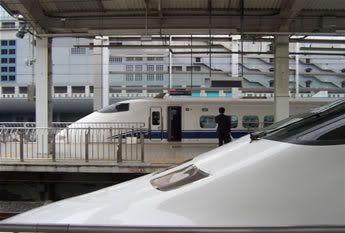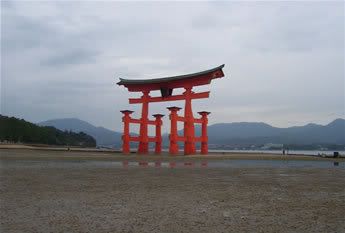Your author in the ryokan, Kyoto
Our longest stay in one place came to an end after five nights in the ryokan in Kyoto. After one last trip up and down the eleven sets of escalators at the jaw-dropping station it was back on the Shinkansen and off to Hiroshima. Tokyo is a great city, but Kyoto seems more like a typical Japanese city - at least my perception of what a Japanese city might look like before I came here and saw one. That's not to say I prefer Kyoto - I like them both for different reasons. There's nothing of the action-packed megacity in Kyoto. Slowly walking around the temples, shrines, and narrow backstreets is by far the best way to see it. It`s possible to get a small idea of what Japan used to look like, something that is very hard in Tokyo. It is a wonderful place to explore, and if you only have time for one city in Japan - it has to be Kyoto.
Shinkansen lining up at Shin-Osaka
A mere 15mins from Kyoto is Osaka, where we changed onto another shinkansen heading west towards Hiroshima. The mightily impressive fast trains have their own private track, so can run at super speeds neatly spaced at 10min intervals. The JR Rail Pass we had was incredible value - for the price of one return trip from Tokyo to Kyoto (you really do pay for the premium travel experience), we get unlimited use on all JR trains, shinkansen (apart from the mega-fast Nozomi type) and ferries, for two weeks. All you have to do is flash the passport-sized bit or card and walk through the ticket barriers. I can't recommend them enough.
O-torii at Miyajima at low tide
At Hiroshima we changed to a local train and got off at Miyajima-guchi where a JR-owned ferry to 10mins to cross the short stretch of water to the island of Miyajima. We opted to stay on the island rather than in a hotel in Hiroshima, and it definately paid off. Our ryokan was small and basic - much less than the one we had left in Kyoto - but it reflected the small island perfectly, and had everything we needed. Miyajima is heavily forested, and apparently has excellent walks - although there were notices up that one of the main trails was closed due to a typhoon-caused landslide. The low grey cloud hung on the serrated hilltops, and light rain fell as we made our way through the small town to the main attraction. Originally the entire island was sacred, and commoners who wanted to go there to worship the God of the Sea weren't allowed to set foot on the land. So in 593 the priests built a shrine over the water on a series of linked, covered boardwalks to ensure pilgrims could safely visit without causing trouble for them by touching the land. But how would the boatloads of worshippers be able to pass through a torii gate in order to enter? Well, build a giant torii in the bay, so they could row underneath it as they approached. This was done, and the floating torii of Miyajima became one of the most famous sights in Japan - in fact, it's another of the "Three Great Views".
...and at high tide
It is extremely impressive, standing anchored in the mud about 50m offshore. We managed to see it at both high and low tides - the former being more visually spectacular, but the latter enabling us to walk over the mud right up to it. It really is colossal - 16m high, 10m in circumference (the main pillars). The familiar vermillion colour really stands out against the sea and mountains. The present torii was built in 1875, and the base of the pillars were surrounded by coins dropped as offerings. The mud was also home to countless small crabs, snails and hermit crabs, which I spent a long time watching scuttle around feeding as they went. Oh - and I also saw a hand-sized giant centipede in a pedestrian underpass, and the world's largest wooden rice scoop (7.7m long, 2.5 tons), so all in all it was a pretty successful day.
That evening in our ryokan we were treated to Kaiseki - a Japanese banquet. Many courses, small amounts, but amazing food. I kept a list of what we ate, so here it is...
1. Small fish fillet, one prawn, small pickles
2. Miso soup with two tiny prawns and fish chunks
3. Sashimi - mackerel, octopus, squid
4. Giant marine snail mixed with avocado served in the shell
5. Cold bacon on ice with a sesame dressing
6. Entire small fish, deep fried
7. Rice and more soup
8. Tea
9. Green tea-flavoured ice cream